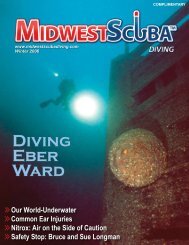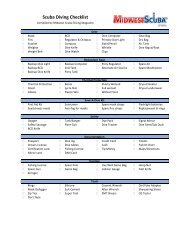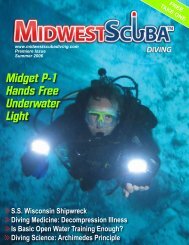great white shark adventure - Midwest Scuba Diving Magazine
great white shark adventure - Midwest Scuba Diving Magazine
great white shark adventure - Midwest Scuba Diving Magazine
Create successful ePaper yourself
Turn your PDF publications into a flip-book with our unique Google optimized e-Paper software.
Rediscovering<br />
Dredge No. 6<br />
By Captain Dale Bennett<br />
incredible story of the sinking of No. 6 Dredge<br />
would be told.<br />
One October day in 2001, Bud Selvick<br />
with his daughter, Lorraine, made a trip to<br />
Milwaukee to revisit the memory of the night<br />
Dredge No. 6 sank. They met Jerry Guyer<br />
and Dave Manchester and reclaimed the<br />
watch Bud’s father lost forty-five years earlier<br />
when a proud vessel and nine men went to the<br />
bottom of the lake. Captain Ed Selvick has<br />
since passed away, but his watch will help<br />
keep his memory alive for future generations<br />
of the Selvick family. Bud and his father had<br />
lived through that night and Bud’s memory of<br />
the incident was as clear as if it had happened<br />
yesterday.<br />
On a Wednesday morning in June of 2000 the<br />
dive charter boat, Len-Der, made its way southsouthwest<br />
from Milwaukee harbor toward a<br />
popular dive site. Captain Jerry Guyer, the<br />
owner, was at the helm as the boat made the<br />
hour-long trip to the wreck then known as<br />
“Dredge 906.” Among the divers on board<br />
were Dave Manchester and Roy Garland.<br />
Dave and Roy were planning to assist Jerry by<br />
replacing the lost mooring line on the wreck,<br />
but what they were about to discover would<br />
open the door to a whole new understanding<br />
of this shipwreck.<br />
This dredge has always been popular with<br />
divers because of its unique configuration. It<br />
is a steel barge with a large house containing<br />
a boiler and machinery for the steam shovel.<br />
It rests upside-down on its spuds in seventyfive<br />
feet of water. “Spuds” are massive steel<br />
columns that can be lowered to the lake floor<br />
to anchor the barge in position while it is<br />
engaged in dredging operations. When in<br />
the retracted position, they normally stick up<br />
into the air. The wreck is suspended above<br />
the bottom on its retracted spuds almost like a<br />
table on legs. The steam shovel with its arm,<br />
boom, wheels, cable and winches is splayed<br />
out over the bottom.<br />
On this day, Dave and Roy tied the new<br />
mooring line to one of the retracted spuds and<br />
then swam down over the edge of the upturned<br />
barge to investigate the crane arm and shovel<br />
which rests on the bottom, off of the bow, to<br />
the north. In the wreckage of the dredging<br />
equipment Roy spied something shiny. He<br />
couldn’t reach it but he pointed it out to Dave.<br />
At first he could not reach it, but after a couple<br />
of tries, Dave was able to maneuver himself<br />
down through the wreckage and reach into<br />
where the treasure rested in a tangled nest of<br />
twisted metal. He retrieved the object and<br />
brushed it off. It turned out to be a gold watch.<br />
Thinking that it may have been dropped by<br />
another diver, he put it in his pocket. It was<br />
not until everyone was back on the deck of<br />
Len-Der that he discovered the inscription on<br />
the back of the watch, “To Ed Selvick, from<br />
Dredge No. 6.”<br />
The watch was proof that the shipwreck<br />
everyone had been calling “Dredge 906” was<br />
actually named “Dredge No. 6.” So how is<br />
it that “Dredge No. 6” came to be known as<br />
“Dredge 906”? Every shipwreck list and article<br />
we have found has published the wrong name.<br />
The story we have heard is that when the Coast<br />
Guard received the initial radio call about the<br />
sinking, they thought they heard, “nine oh six”<br />
when what was spoken over the radio was,<br />
“number six.” “906” was substituted for “No.<br />
6”. We now know, without a doubt, that “No.<br />
6” is the correct name for this wreck. The<br />
watch also puts a very real and personal face<br />
on the disaster witnessed by this wreck.<br />
The Selvick family name is a familiar one<br />
to those involved in Great Lakes shipping.<br />
Jerry remembered that there were Selvicks,<br />
and perhaps an Ed Selvick, living in the<br />
Sturgeon Bay area. All agreed that it would be<br />
appropriate to look up the owner of the watch<br />
and return it to him if possible. It would not be<br />
until October of the next year, however, that<br />
the watch would be returned and the rest of the<br />
On Thursday, May 22nd, 1956 No. 6 Dredge,<br />
owned by Fitzsimmons & Connell Dredge &<br />
Dock Co. of Chicago, was operating off of Oak<br />
Creek, Wisconsin. A new Wisconsin Electric<br />
coal-fired power plant had recently come<br />
on-line, and they had been hired to dredge<br />
out the harbor so that coal deliveries could<br />
be made by water. It was the usual practice<br />
for the crew to live on the vessel, around the<br />
clock, until the job was completed. There was<br />
space aboard for more than twenty-five men<br />
and a cook, but on this day, there were only<br />
19 people on board. The barge was under the<br />
command of Captain Ed Selvick. His son,<br />
Ed junior, also known as Bud, and seventeen<br />
others completed the crew.<br />
The weather, Thursday, was becoming<br />
progressively worse. The harbor at Oak Creek<br />
is unprotected by breakwaters so the barge<br />
was taking the full force of the storm. Late<br />
in the day, it became obvious that she was<br />
in trouble, and the decision was made to tow<br />
the barge to the safety of Milwaukee Harbor.<br />
The Tug, E. James Fusik, began towing the<br />
110-foot barge northward. The weather was<br />
quickly deteriorating. Soon there were fifty<br />
knot winds and the waves rose to fifteen feet.<br />
By 2:00 AM on May 23rd, they had made it to<br />
within seven miles of the breakwater entrance,<br />
about halfway. Waves were washing over the<br />
decks and the equipment rooms were filling<br />
with water. The pumps were not keeping up<br />
with Lake Michigan’s onslaught and the boiler<br />
was in danger of exploding. The barge began<br />
to list badly to one side. The crewmen, many<br />
of whom had been asleep in their bunks, were<br />
ordered to don their lifejackets and report<br />
on deck. Suddenly, a cable which secured<br />
the shovel boom parted with a bang. Eighty<br />
thousand pounds of dredging equipment<br />
was violently thrown over to one side. The<br />
equipment kept moving and the rest of the<br />
barge followed. As the vessel rolled over<br />
and sank, the crew leapt into the frigid spring<br />
water. It all happened in just a few seconds.<br />
The tug’s crew quickly threw off the tow lines<br />
and turned their boat around to try to save the<br />
men in the water. They were able to pick up<br />
ten survivors and three bodies. Four more<br />
bodies were found the next day; two were<br />
never recovered.<br />
Almost from the day she sank, Dredge No.<br />
6 has been a popular destination for Lake<br />
Michigan divers, and even more so in recent<br />
years, since the visibility of the lake has<br />
increased dramatically with the introduction of<br />
exotic species of filter feeders, such as zebra<br />
mussels. The sheer size of the shovel and<br />
crane is awe-inspiring. The shovel itself looks<br />
as if it is big enough to pick up a Volkswagen.<br />
The deck areas around the perimeter of the<br />
barge are easily explored by experienced<br />
divers. For divers with advanced training in<br />
penetration, the equipment and boiler rooms<br />
are very interesting, though a little disorienting.<br />
Because everything is upside-down, ladders<br />
that once descended into the lower levels of<br />
the engine room and boiler room areas now<br />
extend upward into these spaces. Smaller<br />
tool rooms and coal bunkers, complete with<br />
coal, can be found along the sides. These<br />
areas can also be explored, but can be rather<br />
16 MIDWEST SCUBA DIVING FALL 2007










